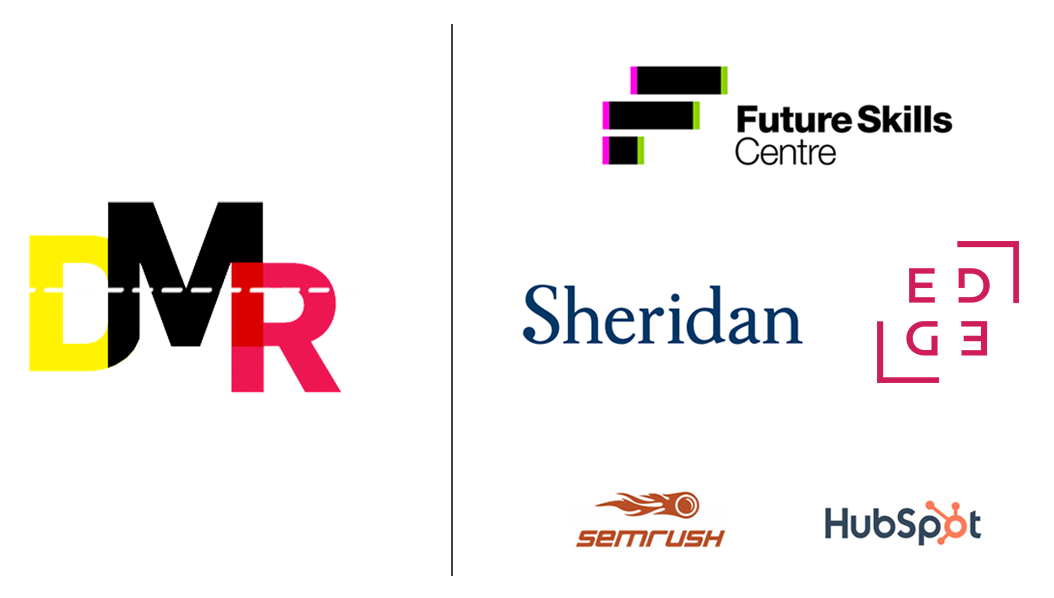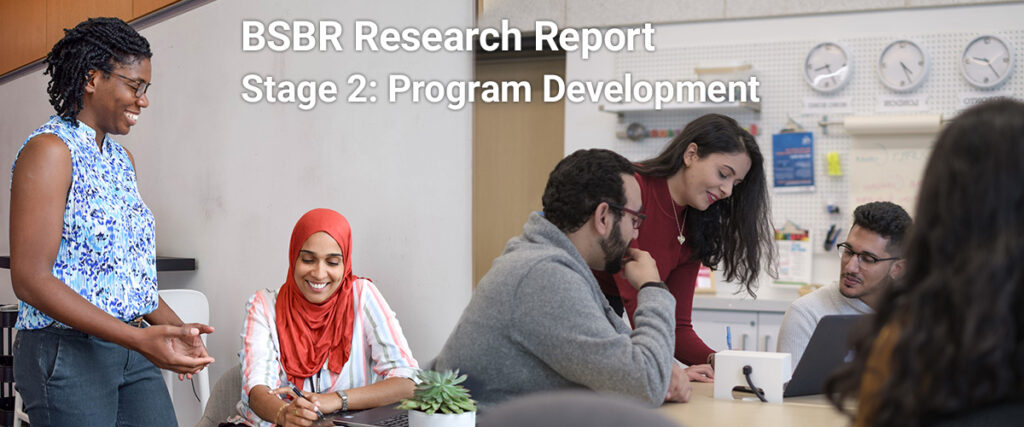The Digital Marketing Research: Building Small Business Resilience (BSBR) Training Program is a shared research initiative by Sheridan’s Pilon School of Business and EDGE, and is funded by the Government of Canada’s Future Skills Centre.
The first two stages of the project are now complete: Program Design and Program Development.
Phase 1: Program Design
Program Design aims to investigate the needs and challenges of underrepresented small business owners to help them pivot and grow their businesses online. The findings from this stage will inform the development of the BSBR Digital Marketing Training Prototype in the Stage 2 of the project.
Over 150 small business owners completed the online survey. Around 50 owners were invited to participate in the online focus group discussion and 26 were chosen to join the first round of our training program.
Here is the summary of our findings.
Owner Profile
During the Program Design stage, we conducted three data collection points: online survey, online discussion board and focus group discussion to gain an understanding of our target market so we can develop a training program that is responsive to their needs.
Our target market is underrepresented small business owners whose businesses have been negatively impacted by the COVID-19 pandemic and are looking to develop their digital marketing skills.
Our research findings revealed the majority of participants identified themselves as women, immigrant and racialized peoples whose employees are also women, immigrant and racialized peoples. Their median age is 43 years old. English is their first language. They are highly educated with 58% having a bachelor’s degree or higher, and 19% having a diploma. They also have high computer literacy with 81% rating themselves as intermediate or advanced level in Microsoft Office.
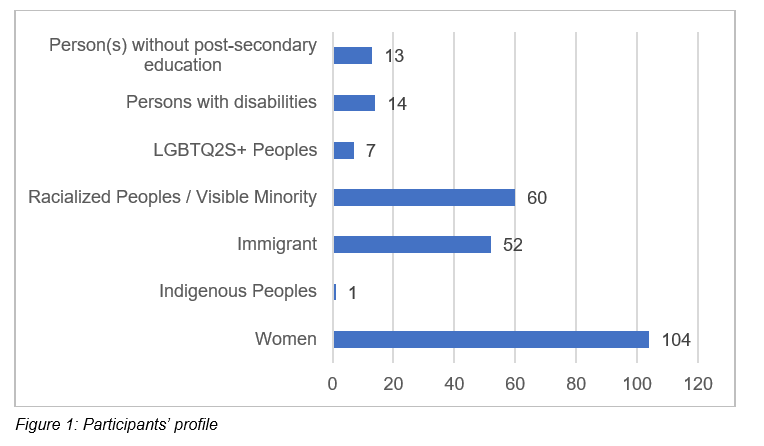
Business Profile
Almost all of the businesses (97%) are based in Ontario and the majority are from Arts; Educational Services; Health Care and Social Assistance; Professional, Scientific and Technical Services; and Retail industry sectors. Their current customers are based locally or in the same province, but they are looking to expand their customer base nationally and internationally.
Their revenue has been impacted by the COVID-19 pandemic. 77% of the businesses experienced a negative growth in their annual revenue with an average of 58% reduction. The rest had a positive revenue growth of around 162%.
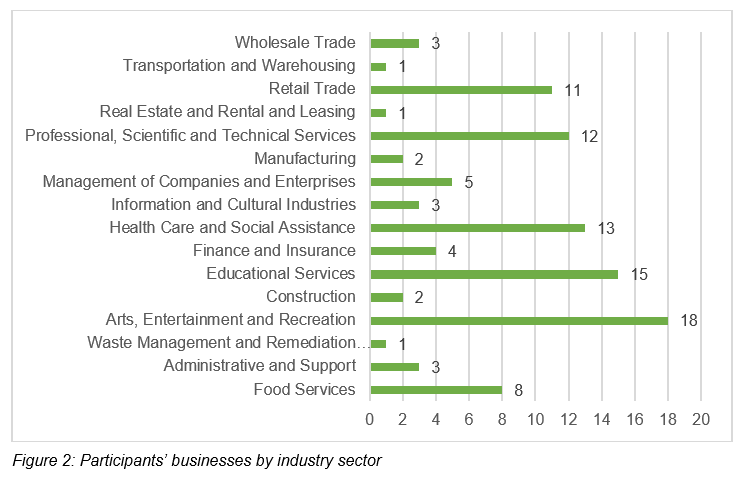
Digital Profile
The research shows our participants are relatively new to digital marketing. On average, they have been operating a business website for 3.5 years, a blog for 0.8 year and an e-commerce site for 1 year. Regarding social media, they have been active on Facebook for 2.6 years, Instagram for 2.4 years, Twitter for 1.4 years, LinkedIn for 1.7 years, YouTube for 0.8 year and email marketing for 2.3 years.
They have a low level of online activities with an average of 2 updates per month. Most frequent updates are on Instagram 6.9 times and Facebook 4.6 times a month. Consequently, their online reach is low with an average 1,126 pageviews, 1,257 Instagram followers, and 427 email subscribers.
38% did not engage in any forms of online advertising. For those who did, Facebook and Instagram advertising were preferred (25%) followed by Google advertising (12%). For non-digital promotion activities, word of mouth was the most popular (65%), followed by store signage (16%), flyers (14%), and direct mail (11%).
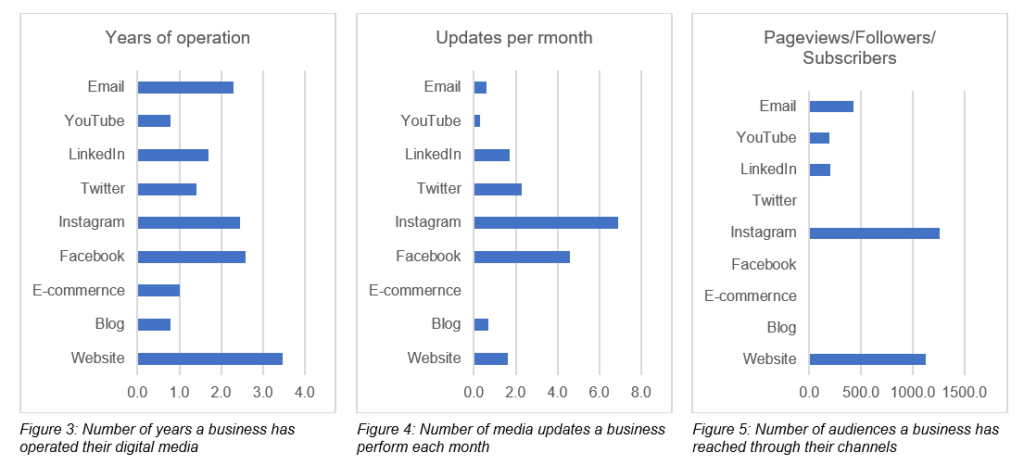
Digital Knowledge and Skills
From the online survey, participants ranked social media marketing as knowledge and skills most important for their business, followed by content marketing, and digital strategy. They ranked influencer marketing and graphic design as least important.
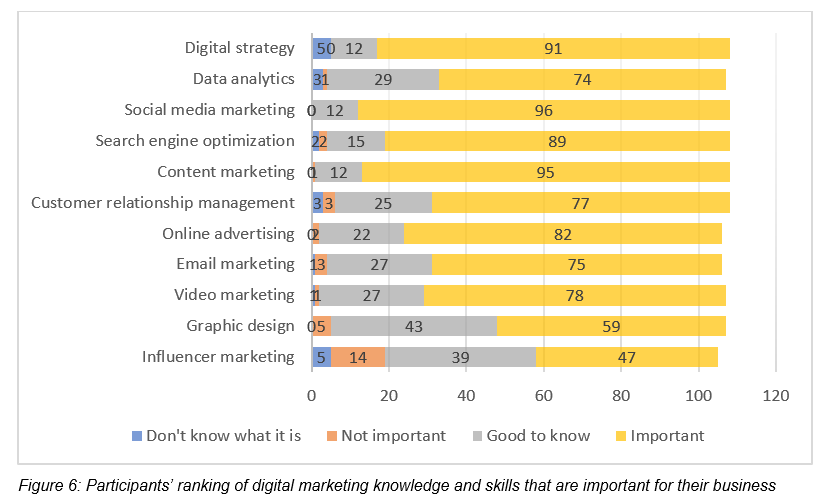
Participants rated themselves mostly as beginners in all aspects of digital marketing with more intermediate skills and knowledge in social media marketing and content marketing.
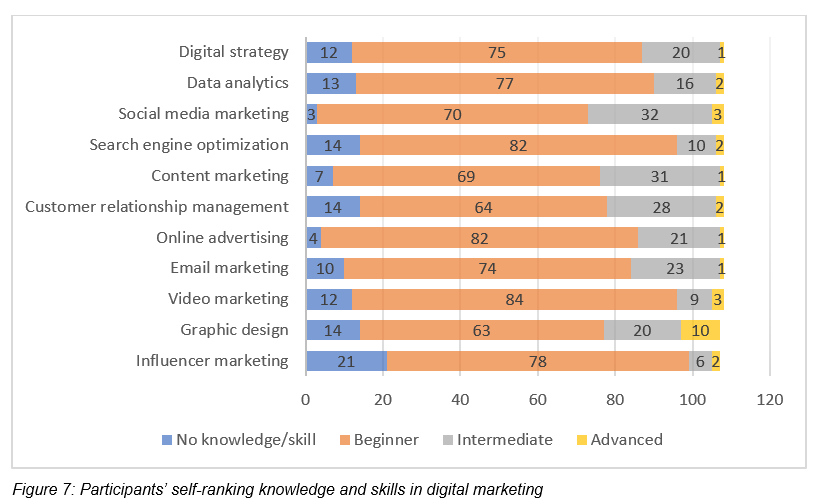
In the focus group discussion, we asked participants to further identify the knowledge and skills needed in their business and perceived gaps in their current skill set. Participants’ feedback was tagged and grouped into learning paths, topics and elements, which will form the learning outcomes of the training program.
- Overwhelmed by everything… find it hard to prioritize or implement any kind of growth strategy
- Had an agency but low ROI and quality
- Can’t analyze my target market properly
- Have Google Analytics but what to do with it
- Which social channels to choose to find my customers
- Where best to spend my marketing dollars
The topics that are emerged as priorities with the most comments are:
- Implementation and tactics: Technical how-to information (24% of the comments)
Participants would like DIY information on how to implement the tactics themselves. - Strategy and Planning: Overall planning (16% of the comments)
Participants need help formulate overall marketing strategy and plans that are purposeful, focused and result driven. - Strategy and Planning: Sales funnel and customer relationship management (12% of the comments)
Participants have problems finding new customers, converting leads (social followers or email subscribers) to customers, and retaining existing customers. - Strategy and Planning: Target market, target audience and persona (11% of the comments)
Participants would like to know who their customers are, where to find them and how to engage with them. - Strategy and Planning: Unique selling proposition (USP) and value proposition (10% of the comments)
Participants have difficulties creating promotional messages, and developing content and stories around the messages.
Program Delivery
From the online survey, participants preferred the training program to be delivered online (65%) over hybrid (20%) and face-to-face (15%) with the recommended class length to be 2.1 hours and the proposed frequency of 2.6 classes per week.
From the online discussion board and focus group discussion, participants voted for 1.5 to 2 hours, twice a week as their preferred class length and frequency. Weekday morning sessions (39%) are preferred over lunch (19%), evenings (17%) and Saturdays (12%) or Sundays (13%).
To give them the best chance to succeed, participants suggested the program should:
- Be flexible: offering alternative class times, video tutorials or recorded sessions for those who miss the class
- Be hands-on: explaining the concepts, showing real and relevant case studies and examples, and working on assignments that are related to their own businesses
- Be result-oriented: if participants can see results or progress, they will be more motivated to continue
- Be accountable: sharing and commenting on each other’s work, learning from each other’s mistakes
- Include coaching time: one-on-one or group sessions after class to help with homework and catch up with lessons
- Offer technical support: especially when using software
- Have learning resources available prior to class so participants can study in advance and use the class to discuss issues
- Include resources like planners, workbooks, tools, and systems to help complete assignments
- Have a peer-support system: class buddy, groups of similar businesses to help and encourage each other and networking opportunity
- Encourage to experiment and not be afraid or worried about failing
- Provide participants with constructive feedback from mentors and peers
Download the Report
For more information, you can read the full report.
Phase 2: Program Development
The goal of the second stage of the research, Program Development, aims to design and develop a 12-week training program specifically for underrepresented small business owners to support them to pivot and grow their businesses online.
We used the findings from the first stage which included online surveys, online discussion boards, and focus group discussions to understand our participants and their needs to develop a customised training program that is relevant and responsive to their businesses.
Here is the summary of our development plan.
1. Who are the participants?
Participant Persona

- Zara is a 43-year-old woman, Canadian born with a Malaysian heritage. She speaks English as a first language
- She has a Bachelor’s degree in Commerce and a high level of computer literacy
- Zara has been running her business in Hamilton, Ontario for 3 years. Her business, Hamilton Stitches, sells hand embroidery kits and supplies as well as offers embroidery classes. Her current customers are mostly in Hamilton.
- During the COVID-19 pandemic, her business experienced negative growth with a 58% reduction in sales revenue as her brick-and-mortar shop was closed during the lockdown. Zara started an e-commerce store about a year ago and would like to expand it to reach customers nationally.
- Zara is still new to digital marketing. Her website was created three years ago but it is more like an online brochure and consists of 3-4 webpages. She started using Facebook two years ago, posting about new classes and new product arrivals about twice a month whenever she could find the time.
- Most of her customers come from word of mouth and passerby. She does not engage in any offline or online advertising.
After 3 years of operation with proven revenue generation, Hamilton Stitches has survived the concept stage and demonstrated that it is a viable business entity. Zara has successfully built a customer base using her brick-and-mortar store presence and traditional word of mouth recommendations. Her customer base is confined within her local community.
The pandemic forced Zara to adopt e-commerce very quickly without having the necessary skills and resources to navigate and capitalize the online market. As a solo entrepreneur, she wears many hats with endless to-do lists, and always runs behind schedule. Zara always searches for new ideas. She improvises and makes up her plans as she goes. She tries out different ideas but is never quite sure which one works. As a result, her online marketing attempts are sporadic and uncoordinated. She would like help planning a cohesive, long-term strategy as well as executing day-to-day tactics with a strong ROI to justify her marketing efforts.
2. What to include in the training
To determine the content of the training program, we use the backward design approach [3], which is a goal-based framework for curriculum development.
2.1 Identify learning outcomes
The first step in the backward design process is to determine the desired goals or learning outcomes, which are the knowledge and skills learners should have acquired when they finish the program.
Our short-term goal at the end of the training program is for Zara to develop (THINK) and execute (DO) a digital marketing campaign plan that is applicable to her own businesses and customer bases; identify elements of success and failures (MEASURE); and make necessary changes (ADAPT) to optimize results. Our long-term goal is for Zara to successfully apply the knowledge and skills to increase her revenues and become resilient against any future economic disruptions.
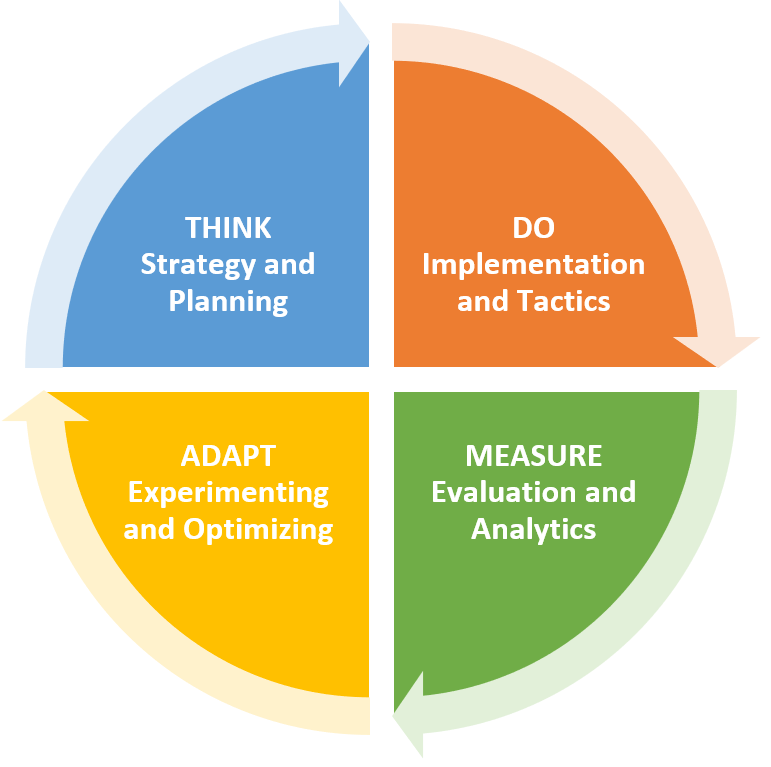
The big idea is for Zara to become self-reliant in digital marketing by teaching her DIY (do-it-yourself) skills so she can continue to plan and execute digital marketing activities, and improve the results by herself.
Once she masters these skills, she can keep experimenting and adapting her marketing efforts to grow her business. Ultimately, her adaptability will protect her business against any future disruption.
We break down the goal into 4 learning outcomes (LO) following the sequence of a marketing process:
LO#1 – THINK: Strategy and Planning
Develop marketing strategy and create a cohesive plan
LO#2 – DO: Implementation and Tactics
Execute the plan using suitable digital tactics
LO#3 – MESAURE: Evaluation and Analytics
Assess the performance using data
LO#4 – ADAPT: Experimenting and Optimizing
Learn from past results to keep improving We chose to adopt a marketing campaign as the learning conduit as it covers critical marketing concepts and offers an opportunity to practice the whole marketing process within a short timeframe.
For information about the Program’s specific learning outcome, learning paths and topics learning elements, please see the Report.
2.2 Determine evidence of learning
We plan to evaluate if Zara has achieved the Big Idea’s learning outcomes by asking her to perform tasks, analyze the results and make recommendations for improvement. She then will be asked to adjust her work, and analyze the results again. This learning experience will guide her through the full cycle of the DIY Continuous Improvement Process. The evaluation will be done by instructors and participants (peer-reviewed).
For information about the Program’s specific performance tasks and evidence of learning, please see the Report.
2.3 Plan learning experience
We plan a variety of learning events and activities for Zara including:
- Pre-training Activities
Zara will be provided with an audit report on her digital performance. This will form part of her SWOT analysis, and subsequently campaign strategy and plan. The Program Workbook will also be available prior to the program start. Zara will be encouraged to start working on the Workbook and answer as many questions as she can.
- Instructor-led Lectures and Workshops
Lectures includes explanation of underpinning theoretical concepts and samples, and using participants’ businesses as case studies. Zara will be guided through a series of questions and activities on the Workbook, which will help her formulate her campaign plan. She will also use the Workbook to record her results and answers questions, which are designed to help her reflect on her campaign results.
- Participant-led Lectures and Workshops
Zara and other participants are invited to share technical how-to tips with the class.
- Show and Tell
Zara and other participants are encouraged to give each other feedback on their tactics: webpage, social posts, e-commerce, online ads, influencers, inbound links and email. Zara and other participants will also share their lessons learned and ideas to better their results.
3. How to offer the training
The BSBR training program is designed following the Universal Design for Learning (UDL) Guidelines, underpinned by the adult learning principles and the experiential learning approach.
The Universal Design for Learning (UDL) Guidelines [4] [5] is a framework to optimize learning experience for all learners by identifying design elements that provide the greatest access for the range of learners in any setting. Its premise is that when we design for particular accessibility needs, all learners benefit. The UDL Guidelines advocate that learners should be provided with multiple means of engagement (the why of learning), multiple means of representation (the what of learning), and multiple means of action and expression (the how of learning).
Adult learning principles [6] recommend that adult learners who are self-directed, should be encouraged to take charge of the content and process of their learning. Their prior knowledge and life experience should be capitalized and built upon with the learning of new concepts. Adult learners are intrinsically motivated by practical, problem-solving content that is directly relevant and applicable to their work or life. They are also result-oriented, so they tend to move quickly from theory to application.
According to Kolb’s Experiential Learning Model (ELM) [7], to develop new knowledge and skills, learners must learn by immersing themselves in an active, hands-on experience; reflecting on that experience; concluding and conceptualizing the experience; and then engaging in experimentation by trying out the newly gained knowledge and skills.
The BSBR Digital Training Program will be delivered online over 12 weeks. The online mode is chosen not only to comply with the COVID-19 health regulations, but also to accommodate participants’ busy schedules. The main advantages of online learning are flexibility and convenience. Participants can join the class in the convenience of their own space with no travel time. However, it is harder to focus and engage with instructors and other learners virtually, which could leave learners to feel isolated and unmotivated. Therefore, the program is designed with frequent touchpoints, offering multiple contact opportunities and channels for participants to engage with instructors, support staff and each other.
Each week, there will be two lecture sessions and one workshop session with ongoing support throughout the program period.
3.1 Lectures
There will be two lecture sessions per week. Some of the sessions will be elective, allowing participants to choose the sessions that are relevant to their businesses. The mandatory sessions provide crucial learning components, which will be scaffolded to create a learning path to achieve the desired learning outcomes.
Each session could consist of 1.5 hours, which could be divided to:
- Introduction (5-10 minutes)
This section is allocated to greetings and introducing the class agenda as well as recapping and answering questions on the last class’s topic.
- Lecture (40-50 minutes)
The lecture section could be instructor-led, participant-led or a combination of both. This section will be recorded to provide an asynchronous learning mode for participants to learn on their own time.
An instructor-led lecture aims to provide participants with theoretical and conceptual foundations on a digital marketing topic with real life samples to illustrate the concepts. For a participant-led lecture, participants will be invited to share their knowledge and skills with the class. We acknowledge that many participants have years of experience in particular areas of digital marketing. Sharing the knowledge with the class will not only benefits others, but also themselves, since one of the best ways to reinforce learning is to teach.
- Case study or show and tell (20-30 minutes)
This case study section is designed to be an open discussion on the topic using one of the participants’ businesses as a case study. The discussion will guide participants to apply the learned concepts by analyzing problems, brainstorming ideas, anticipating potential issues or difficulties, and working out solutions. Case studies will be on the voluntary basis only. If there are no suitable volunteers, external case studies will be used. The case study section will not be recorded to allow for an open and candid discussion.
In the show and tell section, participants are encouraged to share their assignments, including campaign plans, executions and results with their groups and the class. Peer reviews will be adopted so participants can seek feedback and ideas to improve their outcomes and learning.
- Question time (5-10 minutes)
This section is to wrap up and answer questions about the class’s topic.
- Homework (1-2 hours)
Participants will be provided with a Program Workbook, which consists of an assignment for each topic. Generally, the assignment will ask participants to apply the acquired concepts to their own business.
Experimentation is strongly encouraged. Rather than using their own digital platforms which have real customers and audience, participants can use Program’s digital channels to experiment and test their ideas. Mistakes and mishaps are considered crucial learning activities.
BSBR Program’s digital channels are a dedicated learning platform where participants can practise their digital marketing activities. These channels include:
- Website: https://nine.psbdigital.ca/
- Facebook: https://www.facebook.com/PSB9Digital/
- Instagram: https://www.instagram.com/psb9digital/
- Twitter: https://twitter.com/PSB9Digital
- LinkedIn: https://www.linkedin.com/showcase/79696003/
- YouTube: https://www.youtube.com/channel/UCl6r71ARybNVCWj5uw9jKfQ
- Google Ad: These will be undertaken on the participant’s channel with practice in HubSpot
- Facebook Ad: These will be undertaken on the participant’s channel with practice in HubSpot
- HubSpot email: https://app.hubspot.com/email/6800850/manage/state/all
3.2 Workshops
There will be one Instructor-led workshop per week. This optional session is designed to assist participant with their assignments. Participants can choose to attend to ask questions and assistance on how to apply digital marketing concepts to their businesses. The workshop session will be group-based so participants can learn from one another. Participants can share their problems with the group and instructors will guide the discussion for possible solutions. The workshop sessions will not be recorded.
3.3 Support
- Technical Support
Support is available to assist participants with technical issues, mainly software setup, how-to and trouble shooting. The stated and communicated intention will be to answer all enquiries within 48 hours.
- Group Support
Participants will be organized into groups at the beginning of the Program. The goal is to mix participants from different industries with various digital experience and skill levels so participants can share, provide constructive feedback, and learn from one another. The Program is expected to put pressure on small business owners who already have competing demands on their time. The group role is to help their group members complete the assignments as well as motivate and encourage one another to stay the course and complete the program.
- Class Support
There will be an online social group set up for each program cohort to build a community of learning. The social channel will be a safe and open space for collaborating, commenting and sharing their knowledge; providing emotional support and connection as well as networking.
What’s Next
The second stage of the research project, Program Development, is complete. We are ready to progress to the next stage, Alpha Testing, which is the launch of the first training prototype in September 2021.
Download the Report
For more information, you can read the full report.
Interested in Participating?
The application for the Alpha Group Training Program, which will commence in September 2021, is temporarily closed for now. However, space could become available. Please check back in September for further updates.
The January 2022 Beta Group Training Program is fully open for applications. Apply Now.
